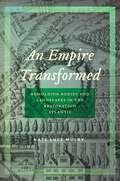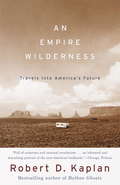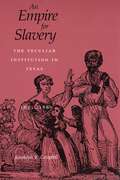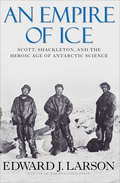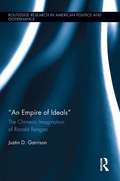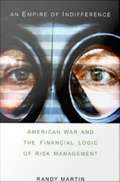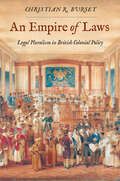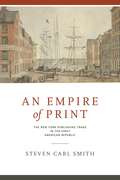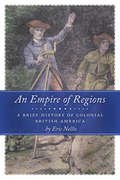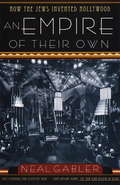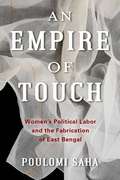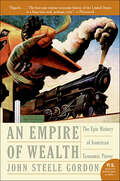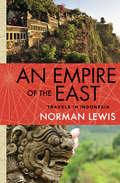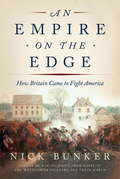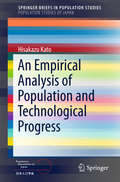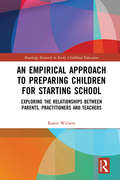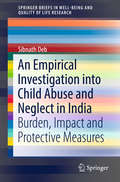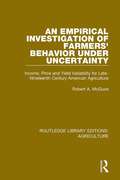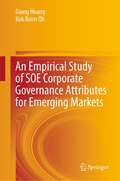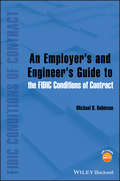- Table View
- List View
An Empire Transformed: Remolding Bodies and Landscapes in the Restoration Atlantic (Early American Places #18)
by Kate Luce MulryExamines the efforts to bring political order to the English empire through projects of environmental improvementWhen Charles II ascended the English throne in 1660 after two decades of civil war, he was confronted with domestic disarray and a sprawling empire in chaos. His government sought to assert control and affirm the King’s sovereignty by touting his stewardship of both England’s land and the improvement of his subjects’ health. By initiating ambitious projects of environmental engineering, including fen and marshland drainage, forest rehabilitation, urban reconstruction, and garden transplantation schemes, agents of the English Restoration government aimed to transform both places and people in service of establishing order. Merchants, colonial officials, and members of the Royal Society encouraged royal intervention in places deemed unhealthy, unproductive, or poorly managed. Their multiple schemes reflected an enduring belief in the complex relationships between the health of individual bodies, personal and communal character, and the landscapes they inhabited.In this deeply researched work, Kate Mulry highlights a period of innovation during which officials reassessed the purpose of colonies, weighed their benefits and drawbacks, and engineered and instituted a range of activities in relation to subjects’ bodies and material environments. These wide-ranging actions offer insights about how restoration officials envisioned authority within a changing English empire.An Empire Transformed is an interdisciplinary work addressing a series of interlocking issues concerning ideas about the environment, governance, and public health in the early modern English Atlantic empire.
An Empire Wilderness
by Robert D. KaplanHaving reported on some of the world's most violent, least understood regions in his bestsellers Balkan Ghosts and The Ends of the Earth, Robert Kaplan now returns to his native land, the United States of America. Traveling, like Tocqueville and John Gunther before him, through a political and cultural landscape in transition, Kaplan reveals a nation shedding a familiar identity as it assumes a radically new one. An Empire Wilderness opens in Fort Leavenworth, Kansas, where the first white settlers moved into Indian country and where Manifest Destiny was born. In a world whose future conflicts can barely be imagined, it is also the place where the army trains its men to fight the next war. "A nostalgic view of the United States is deliberately cultivated here," Kaplan writes, "as if to bind the uncertain future to a reliable past." From Fort Leavenworth, Kaplan travels west to the great cities of the heartland--to St. Louis, once a glorious shipping center expected to outshine imperial Rome and now touted, with its desolate inner city and miles of suburban gated communities, as "the most average American city." Kaplan continues west to Omaha; down through California; north from Mexico, across Arizona, New Mexico, and Texas; up to Montana and Canada, and back through Oregon. He visits Mexican border settlements and dust-blown county sheriffs' offices, Indian reservations and nuclear bomb plants, cattle ranches in the Oklahoma Panhandle, glacier-mantled forests in the Pacific Northwest, swanky postsuburban sprawls and grim bus terminals, and comes, at last, to the great battlefield at Vicksburg, Mississippi, where an earlier generation of Americans gave their lives for their vision of an American future. But what, if anything, he asks, will today's Americans fight and die for? At Vicksburg Kaplan contemplates the new America through which he has just traveled--an America of sharply polarized communities that draws its population from pools of talent far beyond its borders; an America where the distance between winners and losers grows exponentially as corporations assume gov-ernment functions and the wealthy find themselves more closely linked to their business associates in India and China than to their poorer neighbors a few miles away; an America where old loyalties and allegiances are vanishing and new ones are only beginning to emerge. The new America he found is in the pages of this book. Kaplan gives a precise and chilling vision of how the most successful nation the world has ever known is entering the final, and highly uncertain, phase of its history.
An Empire for Slavery: The Peculiar Institution in Texas, 1821--1865
by Randolph B. CampbellBecause Texas emerged from the western frontier relatively late in the formation of the antebellum nation, it is frequently and incorrectly perceived as fundamentally western in its political and social orientation. In fact, most of the settlers of this region were emigrants from the South, and many of these people brought with them their slaves and all aspects of slavery as it had matured in their natives states. In An Empire for Slavery, Randolph B. Campbell examines slavery in the antebellum South's newest state and reveals how central slavery was to Texas history. The "peculiar institution" was perhaps the most important factor in determining the economic development and ideological orientation of the state in the years leading to the Civil War. Campbell points out that although the area of slaveholding in Texas covered only two-fifths of the state by 1860, this area alone was as large as Alabama and Mississippi combined and constituted "a virtual empire for slavery." By the outbreak of the Civil War, the proportion of slaveholders and slaves in Texas was comparable to that of Virginia, the oldest slaveholding state in the Union.Utilizing records such as federal censuses, wills and other probate papers, and the WPA slave narratives, Campbell raises a number of questions concerning the nature of slavery in Texas. What factors encouraged the adoption of slavery? Under what conditions did the Texas slaves exist? What was the societal impact of slavery in this new state? How did the Civil War itself affect slavery in the state? Campbell also reviews the proslavery argument put forward by many early Texas statesmen. What emerges is a picture of a state whose political future was sen as dependent upon the continuance of slavery and whose role in the Civil War was determined by this choice. As a result of this study, Texas is revealed as a state not unlike those of the older South. An Empire for Slavery is the first examination of the "peculiar institution" as it existed in Texas. Historians and general readers alike will find it an essential examination of the region, the period, and the phenomenon of slavery.
An Empire of Ice: Scott, Shackleton, and the Heroic Age of Antarctic Science (Playaway Adult Nonfiction Ser.)
by Edward J. LarsonA Pulitzer Prize–winning author examines South Pole expeditions, &“wrapping the science in plenty of dangerous drama to keep readers engaged&” (Booklist). An Empire of Ice presents a fascinating new take on Antarctic exploration—placing the famed voyages of Norwegian explorer Roald Amundsen, his British rivals Robert Scott and Ernest Shackleton, and others in a larger scientific, social, and geopolitical context. Recounting the Antarctic expeditions of the early twentieth century, the author reveals the British efforts for what they actually were: massive scientific enterprises in which reaching the South Pole was but a spectacular sideshow. By focusing on the larger purpose of these legendary adventures, Edward J. Larson deepens our appreciation of the explorers&’ achievements, shares little-known stories, and shows what the Heroic Age of Antarctic discovery was really about. &“Rather than recounting the story of the race to the pole chronologically, Larson concentrates on various scientific disciplines (like meteorology, glaciology and paleontology) and elucidates the advances made by the polar explorers . . . Covers a lot of ground—science, politics, history, adventure.&” —The New York Times Book Review
An Empire of Ideals: The Chimeric Imagination of Ronald Reagan (Routledge Research in American Politics and Governance)
by Justin D. GarrisonJustin D. Garrison provides an original and groundbreaking analysis of Ronald Reagan’s imagination as it was expressed mainly in his presidential speeches. He argues that the predominant strain of Reagan’s imagination is "chimeric," that is, imbued with a high degree of optimism, romantic dreaminess, naiveté, and illusion. Reagan spoke often about religion, democracy, freedom, conservatism, progress, America’s role in the world, the American people, the American Founding, and peace. These are for him important symbols, which together express his general vision of politics and human existence. These symbols have to be analyzed in depth in order to understand who Reagan really was and what he represented to his admirers. The book concludes that Reagan’s vision contains many dubious elements that present dangers for practical politics and claims that the popularity of Reagan’s imagination among Americans suggests a problematic self-understanding. Surpassing, existing works on Reagan’s ideas and speeches, this book systematically explains the general quality and major components of Reagan’s vision, and it draws upon political theory, aesthetics, and American political thought to analyze his imagination.
An Empire of Indifference: American War and the Financial Logic of Risk Management
by Randy MartinIn this significant Marxist critique of contemporary American imperialism, the cultural theorist Randy Martin argues that a finance-based logic of risk control has come to dominate Americans' everyday lives as well as U. S. foreign and domestic policy. Risk management--the ability to adjust for risk and to leverage it for financial gain--is the key to personal finance as well as the defining element of the massive global market in financial derivatives. The United States wages its amorphous war on terror by leveraging particular interventions (such as Iraq) to much larger ends (winning the war on terror) and by deploying small numbers of troops and targeted weaponry to achieve broad effects. Both in global financial markets and on far-flung battlegrounds, the multiplier effects are difficult to foresee or control. Drawing on theorists including Michel Foucault, Giorgio Agamben, Michael Hardt, Antonio Negri, and Achille Mbembe, Martin illuminates a frightening financial logic that must be understood in order to be countered. Martin maintains that finance divides the world between those able to avail themselves of wealth opportunities through risk taking (investors) and those who cannot do so, who are considered "at risk. " He contends that modern-day American imperialism differs from previous models of imperialism, in which the occupiers engaged with the occupied to "civilize" them, siphon off wealth, or both. American imperialism, by contrast, is an empire of indifference: a massive flight from engagement. The United States urges an embrace of risk and self-management on the occupied and then ignores or dispossesses those who cannot make the grade.
An Empire of Laws: Legal Pluralism in British Colonial Policy (Yale Law Library Series in Legal History and Reference)
by Christian R BursetA compelling reexamination of how Britain used law to shape its empire For many years, Britain tried to impose its own laws on the peoples it conquered, and English common law usually followed the Union Jack. But the common law became less common after Britain emerged from the Seven Years’ War (1754–63) as the world’s most powerful empire. At that point, imperial policymakers adopted a strategy of legal pluralism: some colonies remained under English law, while others, including parts of India and former French territories in North America, retained much of their previous legal regimes. As legal historian Christian R. Burset argues, determining how much English law a colony received depended on what kind of colony Britain wanted to create. Policymakers thought English law could turn any territory into an anglicized, commercial colony; legal pluralism, in contrast, would ensure a colony’s economic and political subordination. Britain’s turn to legal pluralism thus reflected the victory of a new vision of empire—authoritarian, extractive, and tolerant—over more assimilationist and egalitarian alternatives. Among other implications, this helps explain American colonists’ reverence for the common law: it expressed and preserved their equal status in the empire. This book, the first empire-wide overview of law as an instrument of policy in the eighteenth-century British Empire, offers an imaginative rethinking of the relationship between tolerance and empire.
An Empire of Print: The New York Publishing Trade in the Early American Republic (Penn State Series in the History of the Book #28)
by Steven Carl SmithHome to the so-called big five publishers as well as hundreds of smaller presses, renowned literary agents, a vigorous arts scene, and an uncountable number of aspiring and established writers alike, New York City is widely perceived as the publishing capital of the United States and the world. This book traces the origins and early evolution of the city’s rise to literary preeminence. Through five case studies, Steven Carl Smith examines publishing in New York from the post–Revolutionary War period through the Jacksonian era. He discusses the gradual development of local, regional, and national distribution networks, assesses the economic relationships and shared social and cultural practices that connected printers, booksellers, and their customers, and explores the uncharacteristically modern approaches taken by the city’s preindustrial printers and distributors. If the cultural matrix of printed texts served as the primary legitimating vehicle for political debate and literary expression, Smith argues, then deeper understanding of the economic interests and political affiliations of the people who produced these texts gives necessary insight into the emergence of a major American industry. Those involved in New York’s book trade imagined for themselves, like their counterparts in other major seaport cities, a robust business that could satisfy the new nation’s desire for print, and many fulfilled their ambition by cultivating networks that crossed regional boundaries, delivering books to the masses.A fresh interpretation of the market economy in early America, An Empire of Print reveals how New York started on the road to becoming the publishing powerhouse it is today.
An Empire of Print: The New York Publishing Trade in the Early American Republic (Penn State Series in the History of the Book)
by Steven Carl SmithHome to the so-called big five publishers as well as hundreds of smaller presses, renowned literary agents, a vigorous arts scene, and an uncountable number of aspiring and established writers alike, New York City is widely perceived as the publishing capital of the United States and the world. This book traces the origins and early evolution of the city’s rise to literary preeminence.Through five case studies, Steven Carl Smith examines publishing in New York from the post–Revolutionary War period through the Jacksonian era. He discusses the gradual development of local, regional, and national distribution networks, assesses the economic relationships and shared social and cultural practices that connected printers, booksellers, and their customers, and explores the uncharacteristically modern approaches taken by the city’s preindustrial printers and distributors. If the cultural matrix of printed texts served as the primary legitimating vehicle for political debate and literary expression, Smith argues, then deeper understanding of the economic interests and political affiliations of the people who produced these texts gives necessary insight into the emergence of a major American industry. Those involved in New York’s book trade imagined for themselves, like their counterparts in other major seaport cities, a robust business that could satisfy the new nation’s desire for print, and many fulfilled their ambition by cultivating networks that crossed regional boundaries, delivering books to the masses.A fresh interpretation of the market economy in early America, An Empire of Print reveals how New York started on the road to becoming the publishing powerhouse it is today.
An Empire of Regions: A Brief History Of Colonial British America
by Eric NellisAn Empire of Regions is a refreshing interpretation of British American history that demonstrates how the thirteen British mainland colonies grew to function as self-governing entities in distinct regional clusters. In lucid prose, Eric Nellis invites readers to explore the circumstances leading to the colonies' collective defense of their individual interests, and to reevaluate the founding principles of the United States. There is considerable discussion of social conditions and of the British background to the colonies' development. Extensive treatment of slavery, the slave trade, and native populations is provided, while detailed maps illustrate colony boundaries, settlement growth, and the impact of the Proclamation Line. This absorbing and compelling narrative will captivate both newcomers to and enthusiasts of American history.
An Empire of Their Own: How the Jews Invented Hollywood
by Neal GablerA provocative, original, and richly entertaining group biography of the Jewish immigrants who were the moving forces behind the creation of America's motion picture industry. The names Harry Cohn, William Fox, Carl Laemmle, Louis B. Mayer, Jack and Harry Warner, and Adolph Zucker are giants in the history of contemporary Hollywood, outsiders who dared to invent their own vision of the American Dream. Even to this day, the American values defined largely by the movies of these émigrés endure in American cinema and culture. Who these men were, how they came to dominate Hollywood, and what they gained and lost in the process is the exhilarating story of An Empire of Their Own.
An Empire of Touch: Women's Political Labor and the Fabrication of East Bengal (Gender and Culture Series)
by Poulomi SahaIn today’s world of unequal globalization, Bangladesh has drawn international attention for the spate of factory disasters that have taken the lives of numerous garment workers, mostly young women. The contemporary garment industry—and the labor organizing pushing back—draws on a long history of gendered labor division and exploitation in East Bengal, the historical antecedent of Bangladesh. Yet despite the centrality of women’s labor to anticolonial protest and postcolonial state-building, historiography has struggled with what appears to be its absence from the archive.Poulomi Saha offers an innovative account of women’s political labor in East Bengal over more than a century, one that suggests new ways to think about textiles and the gendered labors of their making. An Empire of Touch argues that women have articulated—in writing, in political action, in stitching—their own desires in their own terms. They produce narratives beyond women’s empowerment and independence as global and national projects; they refuse critical pronouncements of their own subjugation. Saha follows the historical traces of how women have claimed their own labor, contending that their political commitments are captured in the material objects of their manufacture. Her analysis of the production of historical memory through and by the bodies of women spans British colonialism and American empire, anticolonial nationalism to neoliberal globalization, depicting East Bengal between development economics and postcolonial studies. Through a material account of text and textile, An Empire of Touch crafts a new narrative of gendered political labor under empire.
An Empire of Wealth: The Epic History of American Economic Power
by John Steele Gordon“Superb . . . the best one-volume economic history of the United States in a long time and, perhaps, ever.” —NewsweekIn this illuminating history, John Steele Gordon tells the extraordinary story of the world’s first economic superpower. He shows how the American economy became not only the world’s largest, but also its most dynamic and innovative. Combining its English political inheritance with its diverse, ambitious population, the nation was able to develop more wealth for more and more people as it grew.Far from a guaranteed success, America’s economy suffered near constant adversity. It survived a profound recession after the Revolution, an unwise decision by Andrew Jackson that left the country without a central bank for nearly eighty years, and the disastrous Great Depression of the 1930s. Yet, having weathered those trials, the economy became vital enough to Americanize the world in recent decades. Virtually every major development in technology in the twentieth century originated in the United States, and as the products of those technologies traveled around the globe, the result was a subtle, peaceful, and pervasive spread of American culture and perspective.
An Empire of the East: Travels in Indonesia
by Norman LewisFrom Sumatra to East Timor and beyond, An Empire of the East is a fascinating look at a rapidly changing island nationIn An Empire of the East, renowned travel essayist Norman Lewis takes readers to Indonesia, where some thirteen thousand islands in the South Pacific are each colored with their own unique cultures and histories. With more than three hundred ethnic groups speaking two hundred fifty languages, the warmth and generosity of the island people is matched only by the country&’s complicated political and social landscape. Lewis&’s account tells of a country whose remarkable cultures—as well as its flora and fauna—are increasingly shaped by the waves of modernity and global tourism.
An Empire on the Edge: How Britain Came to Fight America
by Nick BunkerWritten from a strikingly fresh perspective, this new account of the Boston Tea Party and the origins of the American Revolution shows how a lethal blend of politics, personalities, and economics led to a war that few people welcomed but nobody could prevent. In this powerful but fair-minded narrative, British author Nick Bunker tells the story of the last three years of mutual embitterment that preceded the outbreak of America's war for independence in 1775. It was a tragedy of errors, in which both sides shared responsibility for a conflict that cost the lives of at least twenty thousand Britons and a still larger number of Americans. The British and the colonists failed to see how swiftly they were drifting toward violence until the process had gone beyond the point of no return.At the heart of the book lies the Boston Tea Party, an event that arose from fundamental flaws in the way the British managed their affairs. By the early 1770s, Great Britain had become a nation addicted to financial speculation, led by a political elite beset by internal rivalry and increasingly baffled by a changing world. When the East India Company came close to collapse, it patched together a rescue plan whose disastrous side effect was the destruction of the tea. With lawyers in London calling the Tea Party treason, and with hawks in Parliament crying out for revenge, the British opted for punitive reprisals without foreseeing the resistance they would arouse. For their part, Americans underestimated Britain's determination not to give way. By the late summer of 1774, when the rebels in New England began to arm themselves, the descent into war had become irreversible. Drawing on careful study of primary sources from Britain and the United States, An Empire on the Edge sheds new light on the Tea Party's origins and on the roles of such familiar characters as Benjamin Franklin, John Hancock, and Thomas Hutchinson. The book shows how the king's chief minister, Lord North, found himself driven down the road to bloodshed. At his side was Lord Dartmouth, the colonial secretary, an evangelical Christian renowned for his benevolence. In a story filled with painful ironies, perhaps the saddest was this: that Dartmouth, a man who loved peace, had to write the dispatch that sent the British army out to fight.From the Hardcover edition.
An Empirical Analysis of China's Export Behavior
by Valerie Cerra Sweta Chaman SaxenaA report from the International Monetary Fund.
An Empirical Analysis of Population and Technological Progress (SpringerBriefs in Population Studies)
by Hisakazu KatoAnalyzing the relation between population factors and technological progress is the main purpose of this book. With its declining population, Japan faces the simple but difficult problem of whether sustained economic growth can be maintained. Although there are many studies to investigate future economic growth from the point of view of labor force transition and the decreasing saving rate, technological progress is the most important factor to be considered in the future path of the Japanese economy. Technological progress is the result of innovations or improvements in the quality of human and physical capital. The increase in technological progress, which is measured as total factor productivity (TFP), is realized both by improvements in productivity in the short term and by economic developments in the long term. The author investigates the relationship of population factors and productivity, focusing on productivity improvement in the short term. Many discussions have long been held about the relation between population and technological progress. From the old Malthusian model to the modern endogenous economic growth models, various theories are developed in the context of growth theory. In this book, these discussions are summarized briefly, with an analysis of the quantitative relation between population and technological progress using country-based panel data in recent periods.
An Empirical Approach to Preparing Children for Starting School: Exploring the Relationships between Parents, Practitioners and Teachers (Routledge Research in Early Childhood Education)
by Karen WickettThis book presents an exploration of the beliefs held by parents, Early Childhood Education and Care (ECEC) practitioners and teachers and their relationships during children’s transition to school. This exploration was prompted by the author’s observations that the relationships between ECEC practitioners and teachers became increasingly strained when the term school readiness was introduced to the EYFS. Drawing on the findings of empirical research, the book presents the four qualities of relationships between parents, ECEC practitioners and teachers during children’s transition to school. Unlike many current texts, this book extends the transition to include the phases of preparation and adjustment and explores how the qualities of relationships between parents, ECEC practitioners and teachers can change throughout thephases of the transition. The conceptual framework, ‘The Relational Transition to School’ is developed and is a useful tool for researchers and those working together to explore the qualities of relationships between those supporting children during a transition. An Empirical Approach to Preparing Children for Starting School will be of great interest to researchers, academics and postgraduate students in the field of early childhood education, as well as those training to be early years practitioners.
An Empirical Investigation into Child Abuse and Neglect in India: Burden, Impact And Protective Measures (SpringerBriefs in Well-Being and Quality of Life Research)
by Sibnath DebThis book provides a comprehensive overview of child abuse and neglect globally in general terms and with empirical evidence from Puducherry, India. The study unearths the reality concerning child safety and raises a number of questions about child safety measures at the institutional and family levels. It recommends evidence-based and culture-specific preventive measures for child protection. The empirical evidence presented here provides important and useful information to school administrators on the issues of child abuse and neglect, for them to take evidence-based protective measures both at school and at home. For cross-cultural comparison, the findings are of interest to international scholars and academics. This work is useful for policy makers, educators, NGO personnel, child rights activists and opinion leaders in government departments dealing with children, and for researchers in the fields of psychology, social work, nursing, pediatric, forensic medicine, and public health.
An Empirical Investigation of Exchange Rate Pass-Through in South Africa
by Ashok BhundiaA report from the International Monetary Fund.
An Empirical Investigation of Farmers Behavior Under Uncertainty: Income, Price and Yield Variability for Late-Nineteenth Century American Agriculture (Routledge Library Editions: Agriculture #12)
by Robert A. McGuireThis study, first published in 1985, aims to provide objective measures of the risks associated with various crops and livestock in the late nineteenth century and to examine two important issues in American economic history. Knowledge of these risks if a necessity to the profession, if analyses of the uncertainties of postbellum agriculture are to continue. Without this knowledge, assertions which have little or no empirical content will continue to be made. This title will be of great interest to students of economics and agriculture.
An Empirical Investigation of the Exchange Rate Pass-Through to Inflation in Tanzania
by Nkunde MwaseA report from the International Monetary Fund.
An Empirical Reassessment of the Relationship Between Finance and Growth
by Giovanni FavaraA report from the International Monetary Fund.
An Empirical Study of SOE Corporate Governance Attributes for Emerging Markets
by Giang Hoang Kok Boon OhThis book investigates the institutional characteristics of state-linked firms in Vietnam to draw lessons for investors/MNCs targeting Vietnam and other emerging markets in the region. Vietnam and many other ASEAN countries have gone through a period of privatization and equitization of wholly controlled SOEs, with the State retaining partial ownership in many privatized businesses. This book explains the dynamic relationships between the State, BODs, shareholders, and regulators and their influence on corporate governance and SOE performance. This book differs from other publications in that it extrapolates the findings from our study to a broader context on how the defined internal mechanisms implicate the local economy and global supply chains/markets. This book investigates robust theoretical foundations, and rigorous applied empirical research underpin the role of the State in SOEs. It differs from other studies in terms of qualitative and empirical research to provide the contextual setting to elucidate how to successfully navigate emerging market business with the State as an "owner-participant." This book explains the theoretical constructs of corporate governance in SOEs, applies empirical research methodologies, and draws results to validate inferences to (1) investigate the link between the board of directors and ownership attributes and agency cost levels using Vietnamese listed firms for the period from 2006 to 2013, (2) evaluate the effectiveness of State's corporate initiatives and monitoring through its sovereign wealth fund known as the State Capital Investment Corporation (SCIC), and (3) infer and explain the motivation of the State as a shareholder. This book takes cognizance of Vietnam's idiosyncratic institutional (using its sovereign wealth fund as an investment vehicle and management proxy), economic, regulatory, and corporate environments and the realities for developing an effective and sustainable business model, vis-à-vis the ownership structure, board of directors' composition and corporate governance, for better business performance. While the focus is on Vietnam, the content is also relevant to the role of the State in other emerging markets as a player in shaping the business strategy, model, and direction of SOEs.
An Employer's and Engineer's Guide to the FIDIC Conditions of Contract
by Michael D. RobinsonWhen all parties involved in the construction process fully understand their roles and are able to anticipate potential points of conflict, disputes and delays will be minimised. The Employer’s and Engineer’s Guide to the FIDIC Conditions of Contract sets out the essential administrative requirements of a FIDIC based contract by reference to the FIDIC 1999 Red Book. The obligations and duties of the Employer and the Engineer are identified and discussed. Potential pitfalls are highlighted and likely consequences pointed out. The importance of the Employer’s role in the preparation of tenders, which fully reflect his requirements and duties and obligations arising in the execution of the works, is emphasised. The key role of the Engineer in the effective administration of contracts after award is examined and commentary provided. Included in the guide are a number of appendices, including model letters which will be of value to less experienced staff (particularly those whose mother-tongue is not the English language). Engineers, quantity surveyors and project managers engaged in the contractual administration of international projects using FIDIC forms of contract will find the concise guidance in simple and jargon-free language provided here invaluable. This, together with the author’s earlier book, Contractor’s Guide to the FIDIC Conditions of Contract - which describes the duties, rights and responsibilities of the Contractor – represents the totality of supervision, design and execution of construction projects executed under the FIDIC Conditions of Contract. This book’s companion website offers invaluable resources to freely download, adapt and use: Model letters for use by the Employer Model letters for use by the Contractor Sample Interim Payment Certificate Model Form for Submissions to the Engineer Model Form of Engineer’s Order for Varied Works Model Form of Daywork/Daily Record Sheets
